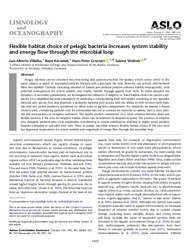Flexible habitat choice of pelagic bacteria increases system stability and energy flow through the microbial loop
DOI: https://doi.org/10.1002/lno.12091
Persistent URL: http://resolver.sub.uni-goettingen.de/purl?gldocs-11858/10225
Persistent URL: http://resolver.sub.uni-goettingen.de/purl?gldocs-11858/10225
Villalba, Luis Alberto; Karnatak, Rajat; Grossart, Hans‐Peter; Wollrab, Sabine, 2022: Flexible habitat choice of pelagic bacteria increases system stability and energy flow through the microbial loop. In: Limnology and Oceanography, Band 67, 6: 1402 - 1415, DOI: 10.1002/lno.12091.
 |
Dokument öffnen: |
Pelagic bacteria can be classified into free‐living and particle‐attached life modes, which either dwell in the water column or attach to suspended particles. Bacteria with a generalist life style, however, can actively shift between these two habitats. Globally increasing densities of natural and artificial particles enhance habitat heterogeneity, with potential consequences for system stability and trophic transfer through aquatic food webs. To better decipher the dynamics of microbial communities, we investigated the influence of adaptive vs. fixed habitat choice on species coexistence for a simplified bacterial community by analyzing a corresponding food web model, consisting of two specialist bacterial prey species (free and attached), a generalist bacterial prey species with the ability to shift between both habitats, and two protist predators, specialized on either water or particle compartment. For simplicity we assume a shared resource pool, considering particles only for colonization but not as a source for nutrients or carbon, that is, inert particles like microplastics or inorganic sediments. The model predicts coexistence on a cyclic attractor between fixed and flexible bacteria, if the costs for adaptive habitat choice can be balanced by adaptation speed. The presence of adaptive prey dampens predator–prey cycle amplitudes, contributing to system stabilization resulting in higher mean predator biomass compared to specialist prey only. Thus, in pelagic microbial systems, flexible habitat choice at the prey level has important implications for system stability and magnitude of energy flow through the microbial loop.
Statistik:
ZugriffsstatistikSammlung:
This is an open access article under the terms of the Creative Commons Attribution‐NonCommercial License, which permits use, distribution and reproduction in any medium, provided the original work is properly cited and is not used for commercial purposes.

